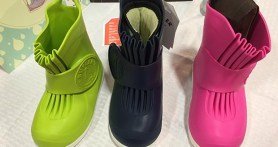

Just like their owners, dogs can show allergic symptoms when their immune systems begin to recognize certain everyday substances and allergens as dangerous. Fall dog allergies become problematic when your dog inhales or ingests allergens, or even when they come in contact with your dog’s skin. As a dog’s body tries to rid itself of these substances, a variety of skin, digestive, and respiratory symptoms can appear, which is why you should know what signs to look for in your dog.
Although fall does not have all the blooms and new growths that bother many, such as pollen and grass, it does have dying plants, wind, moisture, and chillier temperatures that can stir up irritants. The fall also brings mold, which has the ability to negatively affect your pet whether he or she is allergic or not. Fall dog allergies stink, trust us we know.
However, some veterinarians say that seasonal allergies are not limited to springtime, and that pets with fall symptoms are often allergic to weeds that pollinate in the fall, especially ragweed. Other weeds that are known to cause allergic reactions in the fall include sagebrush, Russian thistle, plantain, cocklebur, and lamb’s-quarters.
Common signs of fall dog allergies can include:
- Nasal and eye discharge
- Puffy red eyes
- Ear infections

- Pruritus (itching/scratching, licking/chewing at body parts)
- Fur loss or color change (tears and saliva contain porphyrins, which stain light colored fur pink to brown)
- Itchy, red, moist or scabbed skin
- Itchy, runny eyes
- Diarrhea
- Sneezing
- Coughing
- Vomiting
What do I do if I think my dog has allergies?
You should visit your veterinarian, who will then take a complete history and conduct a physical examination, and hopefully then be able to determine the source of your dog’s allergic reaction. If this isn’t the case, your vet will likely recommend skin or blood tests, or a special elimination diet to get to the root of the problem.
What are some common fall dog allergies we see?
There aren’t really any specific “fall” allergies, but there are some that tend to surface with seasonal changes. Below are a few general ones that are good to be aware of.
- Trees, grass, and pollens
- Mold spores
- Dander
- Feathers
- Fleas and flea-control products
- Rubber and plastic materials
- Fabrics

Immune systems for most canines will adapt to the seasonal changes we experience. However, with animals that aren’t quite able to self-adjust, we as pet owners sometimes need to step in and intervene with eye/ear drops, oral or injectable medications, nutraceuticals, baths, conditioning rinses, and more.
There are a ton of factors that can play a part in affecting your dog’s immune system health, likely making the management of his or her allergies complicated. Allergens will cling to your canine’s coat. Rover is outside sniffing around, breathing in and walking through potential allergens all the time. Also, dogs are only able to sweat through the pads of their feet and the tip of their nose, so they become like wet ‘Swiffer’ pads during allergy season. They’re collecting billions of allergens on and in their bodies throughout the warm months of the year.
8 Tips for Managing Fall Dog Allergies:
- The first step is a veterinary evaluation to ensure your pet doesn’t have a secondary bacterial infection that requires antibiotics.
- Bathe your dog after camping, hiking, etc. If your pet has irritated skin, bathing will rinse the allergens away and make your canine feel better immediately. Don’t be shy about how often you bathe your pet, especially if he or she is suffering from allergies that itch and irritate her skin. Discuss with your veterinarian what prescription shampoos are best, as frequent bathing with the wrong product can dry out skin.
- Foot soaks after outdoor adventures are also a great way to reduce the amount of allergens your pet tracks into the house and spreads all over his or her indoor environment.

- Use topical and/or oral anti-parasite (flea, tick, etc.) treatments per the guidance of your veterinarian.
- Use an over-the-counter eye irrigating solution to rinse your pet’s eyes on an as needed basis.
- Vacuum all carpeting and upholstery and wash all pet and human bedding at least once every seven days.
- Start a flea control program for all of your pets before the season starts. Remember, outdoor pets can carry fleas inside to indoor pets. See your veterinarian for advice about the best flea control products for your dog and the environment.
- Provide a moist, freshly prepared, whole food-based diet having human-grade protein, vegetables, fruits, fat, and fiber. Avoid ingredients that are lacking in protein and grain “meals and by-products,” artificial colors and flavors, moistening agents (propylene glycol, carrageenan, etc.), sugar, rendered fat, and other feed-grade components (as typically go into commercially available dog and cat foods).









